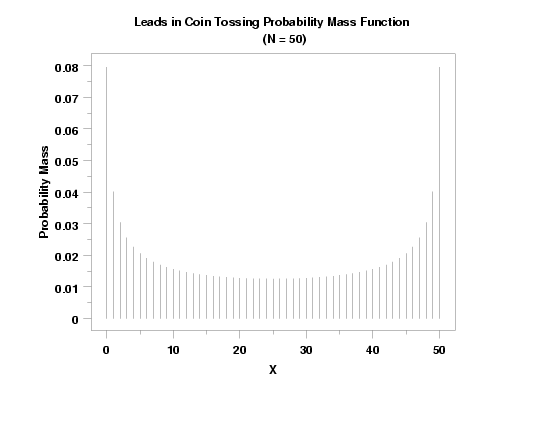

|
LCTPDFName:

with n a non-negative integer denoting the shape parameter. Given 2n coin tosses, let 2k denote the last coin toss for which the cumulative number of heads and tails were equal (0 ≤ k ≤ n). The leads in coin tossing distribution is the distribution of k. We use 2n and 2k since a tie can only occur on an even number toss. Feller (see Further Information below) points out that the common belief that in a long coin-tossing game that each player will be on the winning side approximately half the time with frequent lead changes is in fact erroneous. Frequent lead changes implies that k should be close to n. However, for this distribution the probability that x = k is equal to the probability that x = n - k. The implication of this is that with probability 1/2 no equalization will occur in the second half of the game regardless of the length of the game. The mean and variance of the leads in coin tossing distribution are:

variance = The leads in coin tossing distribution is also known as the discrete arcsine distribution.
where <x> is a variable, a number, or a parameter containing values between 0 and <n>; <n> is a number or parameter that defines the upper limit of the leads in coin tossing distribution; <y> is a variable or a parameter (depending on what <x> is) where the computed pdf value is stored; and where the <SUBSET/EXCEPT/FOR qualification> is optional.
LET Y = LCTPDF(X,100)
LET N = <value> LET Y = LEADS IN COIN TOSSING RANDOM NUMBERS ... FOR I = 1 1 N
LEADS IN COIN TOSSING PROBABILITY PLOT Y
LEADS IN COIN TOSSING CHI-SQUARE GOODNESS OF FIT Y Dataplot does not provide any explicit parameter estimation methods. For this distribution, we simply subtract the minimum value (so the data starts at zero) and then use the maximum value as the estimate of N. We can then apply goodness of fit tests (i.e., the probability plot or the chi-square goodness of fit) to see if the leads in coin tossing is an appropriate distribution.
Johnson, Kotz, and Kemp (1992), "Univariate Discrete Distributions", Second Edition, Wiley, pp. 274-275.
TITLE CASE ASIS
TITLE Leads in Coin Tossing Probability Mass Function CR() ...
(N = 50)
LABEL CASE ASIS
Y1LABEL Probability Mass
X1LABEL X
LINE BLANK
SPIKE ON
TIC OFFSET UNITS SCREEN
TIC OFFSET 3 3
PLOT LCTPDF(X,50) FOR X = 0 1 50

Date created: 6/20/2006 |